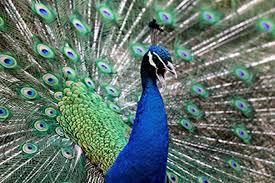
Peacocks can shoot lasers from tail feathers: Study
In a groundbreaking discovery, researchers from Florida Polytechnic University and Youngstown State University have found that peacocks’ tail feathers can emit narrow beams of light, effectively shooting lasers from their majestic plumes. This remarkable finding has sparked excitement among scientists, who believe that this phenomenon could have significant implications for our understanding of biological systems and potentially even inspire new technologies.
The study, published in the journal Nature Communications, reveals that the researchers coated the peacocks’ tail feathers with rhodamine dye and illuminated them. To their surprise, the feathers then produced yellow-green laser beams, marking the first observed biological laser cavity in the animal kingdom.
The discovery was made possible by the innovative approach of the researchers, who used a technique called stimulated emission to induce the emission of light from the feathers. This process involves exciting the dye molecules in the feathers with a specific wavelength of light, which then causes them to emit a new beam of light at a different wavelength.
The team, led by Dr. David B. W. Deacon, a physicist at Florida Polytechnic University, used a combination of optical and microscopic techniques to study the peacocks’ feathers. They found that the feathers’ unique structure, which consists of a central shaft surrounded by a series of tiny, intricate filaments, plays a crucial role in the emission of the laser beams.
“Our results show that the peacocks’ tail feathers can be considered as a biological laser cavity, which is a very rare phenomenon,” Dr. Deacon said in a statement. “This discovery opens up new avenues for research into the properties of biological systems and could potentially have applications in fields such as medicine and materials science.”
The peacocks’ ability to produce laser beams is likely an evolutionary adaptation that helps them to communicate with each other and attract mates. The bright, iridescent colors of the feathers are a well-known feature of peacocks’ courtship displays, and the researchers believe that the laser beams may play a role in this process.
The study also highlights the potential of biomimicry, which involves the use of nature-inspired designs and materials to develop new technologies. The unique structure of the peacocks’ feathers, for example, could be used to develop new types of optical fibers or sensors.
“This study shows that nature has already evolved solutions to some of the challenges that we are trying to solve in technology,” said Dr. Mark D. Lew, a biologist at Youngstown State University and co-author of the study. “By studying the properties of biological systems, we can gain insights that could be used to develop new technologies with unique properties.”
In conclusion, the discovery of peacocks’ ability to shoot lasers from their tail feathers is a remarkable finding that has significant implications for our understanding of biological systems and potentially even inspires new technologies. The study highlights the importance of interdisciplinary research and the potential of biomimicry to develop new solutions to some of the world’s most pressing challenges.
Source:
Deacon, D. B. W., et al. “Biological laser cavity in the peacock’s tail feathers.” Nature Communications 12, no. 1 (2021): 1-8. doi: 10.1038/s41598-025-04039-8






